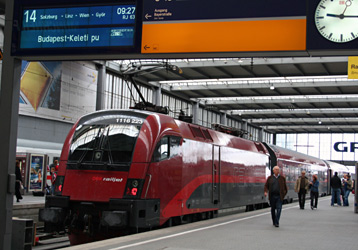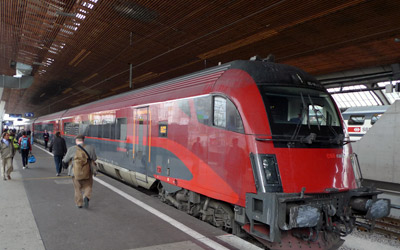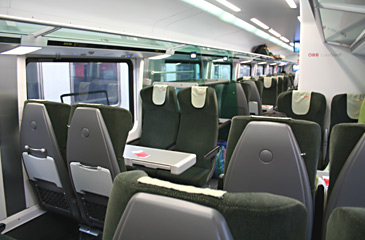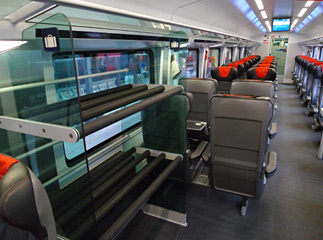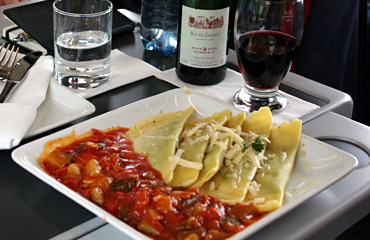What is railjet?
RailJet is Austrian Railways (ÖBB's) high-speed train, capable of 230 km/h (143 mph) where the route allows. RailJet trains operate on the following routes:
Munich Hbf - Salzburg - Linz -
Vienna Hbf -
Budapest Keleti
Zurich HB - Innsbruck - Salzburg - Linz -
Vienna Hbf -
Budapest Keleti (
see the Arlberg Railway page)
Vienna Hbf - Graz - Klagenfurt - Udine - Venice Santa Lucia (
see the Vienna to Venice page).
Prague Hlavni -
Vienna Hbf - Graz (some trains on this route are
blue Czech Railways railjets)
What's it like on board a railjet?
RailJet has 3 classes,
economy class, first class &
business class, all with free WiFi.
Business class is a premium first class, called
Premium class until 2012. The train is all non-smoking. Wheelchair-accessible toilets and several wheelchair spaces are available in each train.
All aboard! A morning railjet about to leave Munich for Vienna & Budapest. Munich Hauptbahnhof is just 15 minutes walk from Munich's famous Dom & Marienplatz.
RailJet from Switzerland... A railjet about to leave Zurich for Innsbruck, Salzburg & Vienna. railjets are 'push-pull', with a locomotive at one end & a driving cab (shown here) at the other.
The railjet has landed... A railjet has arrived spot on time in Budapest's historic Keleti station, built 1881-1884
Economy (2nd class )...
Economy (2nd) class has open-plan seating arranged 2+2 across the car width, most unidirectional but with some tables for 4. All seats have power sockets and a fixed or drop-down table. Large luggage racks are located at various points within the seating area, see the photo of the luggage rack in 1st class below, it's the same in all classes.
See larger photo.
See the seat numbering plan here.
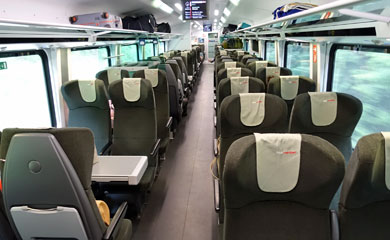 1st class...
1st class...
1st class has reclining leather seats arranged 2+1 across the car width, with tables for 2, tables for 4 people and some unidirectional seats. There are power sockets & tables at all seats. Food & drink orders are taken from the restaurant menu & served at your seat, although meals aren't included in the fare.
See larger photo.
See panorama photo.
See the seat numbering plan here.
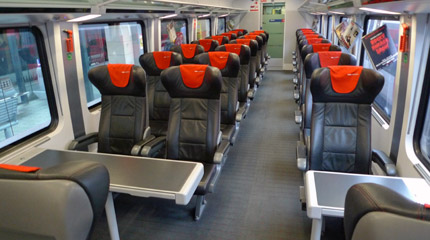
There are luggage racks like this in all classes...
1st class with tables for 2 & 4 and unidirectional seats.
Larger photo.
Business class (premium 1st)...
You pay an extra €15 on top of any 1st class fare to get a business class seat, which automatically includes a reserved seat. Most railjets have only 14 business class seats (half of one car): A carpeted corridor runs down one side of the car, off which open several spacious 3 or 4 seat semi-compartments,
semi because the compartments have no door and partitions are not ceiling-high. Each semi-compartment has very comfortable reclining leather armchairs with adjustable footrests & fold-out armrest table. On a few of the latest railjets (including those used on the
Vienna-Venice route) there are just 6 business class seats, arranged open-plan 1+1 across the car width at one end of the train. There are power sockets & reading lights at all seats. A complimentary welcome drink of wine or fruit juice is included. Food & drink orders are taken from the restaurant menu and served at your seat, although meals aren't included in the fare. If you don't mind the extra cost, business class is highly recommended! Note that only certain booking sites can book business class (for example
www.oebb.at where you select a 1st class fare then choose a business class reservation), but if you have a first class ticket you can find any empty seat and ask to pay the €15 supplement on board.
See larger photo. See panorama photo. See the seat numbering plan here.
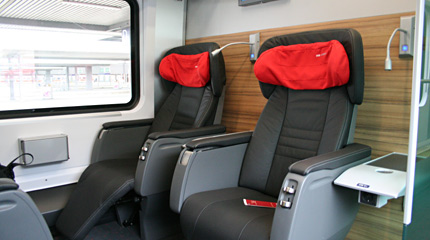
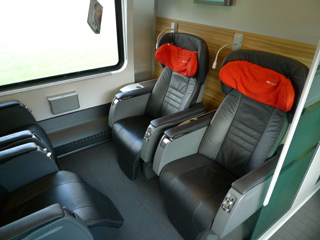 Bistro-restaurant car...
Bistro-restaurant car...
Anyone in any class can buy food & drink at the counter to take back to their seat or you can sit down and use the small waiter-service restaurant area. However, in 1st & Business classes there's no need to go to the restaurant car, staff will take your order and serve you from the restaurant menu at your seat. Food is served on proper china with metal cutlery - no airline plastic here!
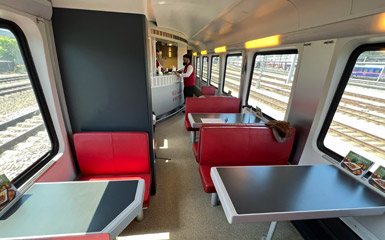
Restaurant & bar counter area.
Larger photo.
Food orders are taken & served at seat in 1st & business.
[...]





